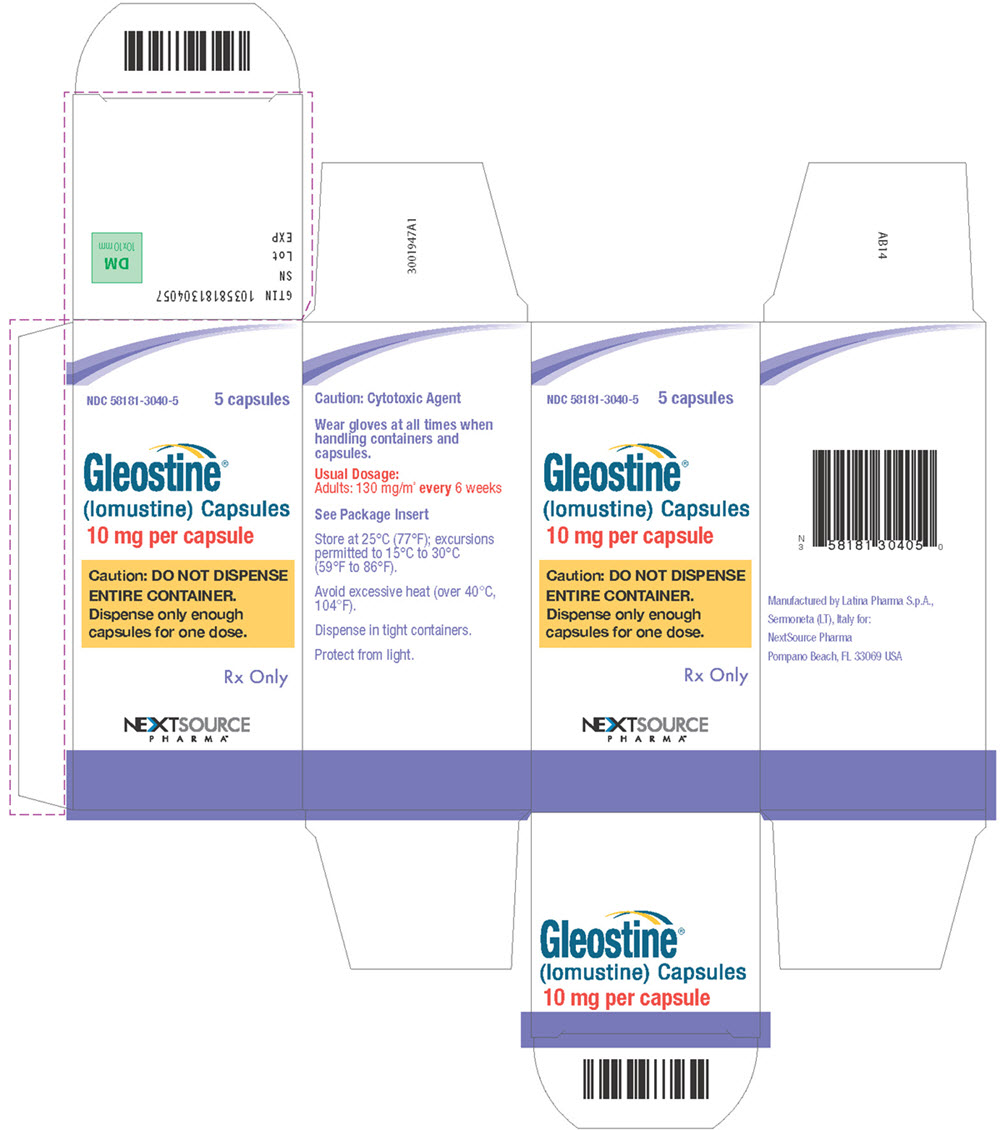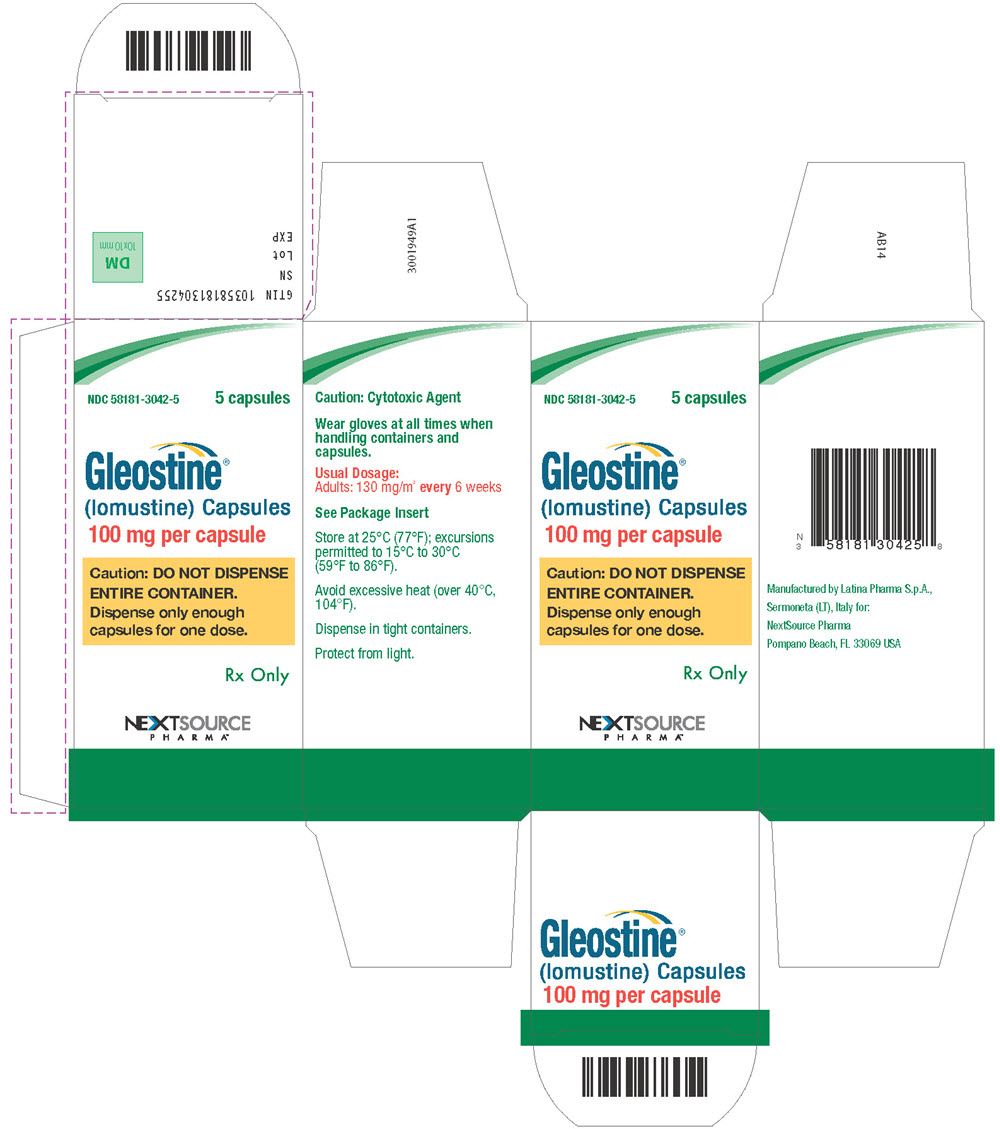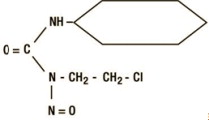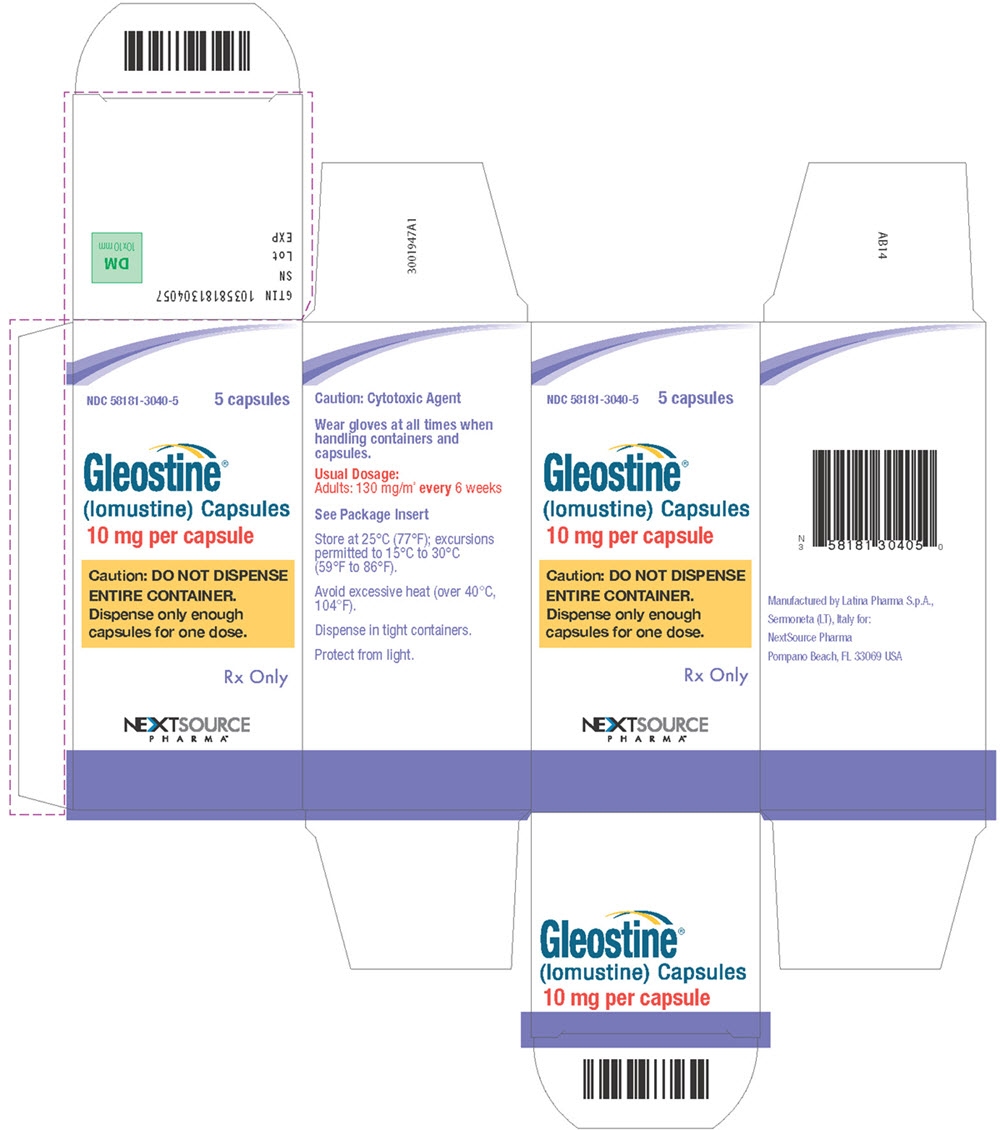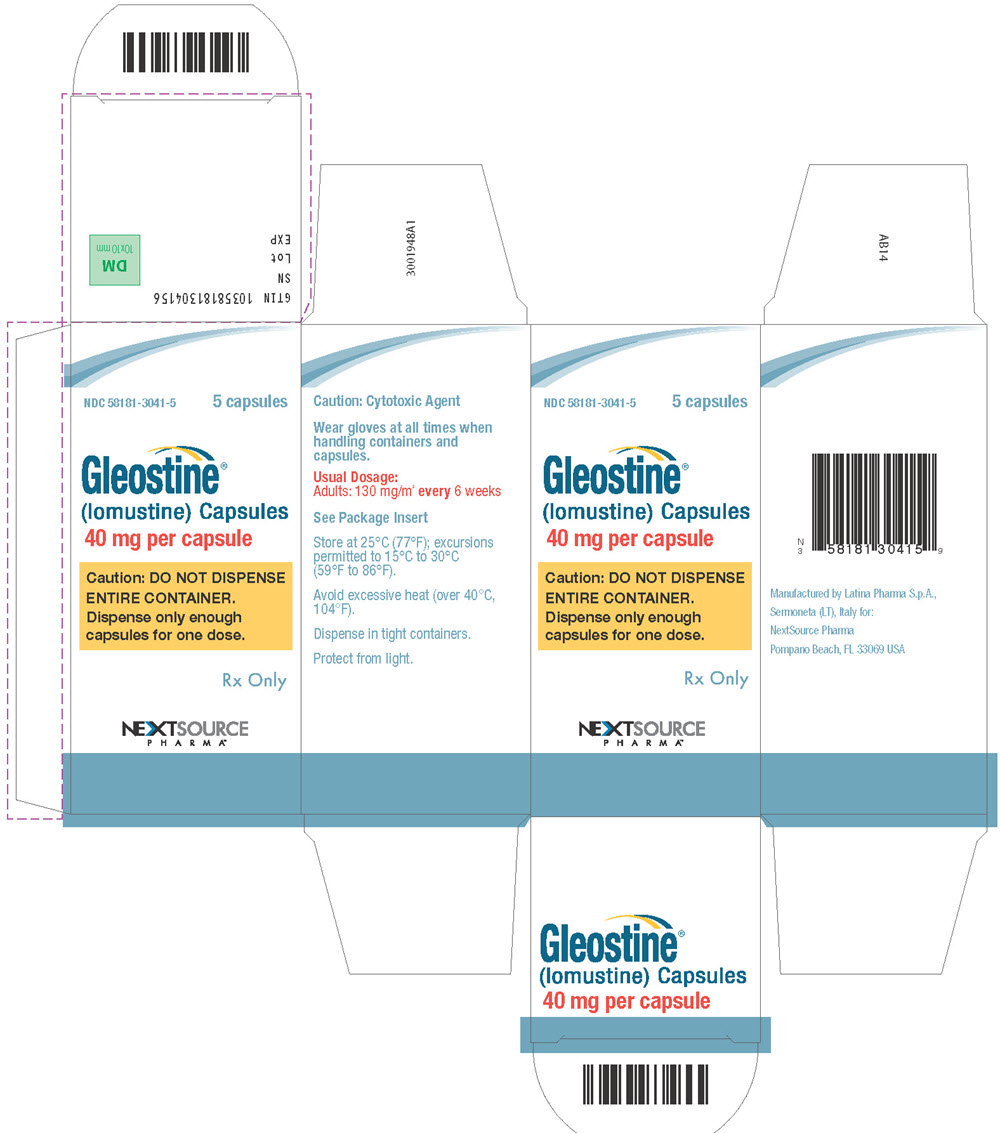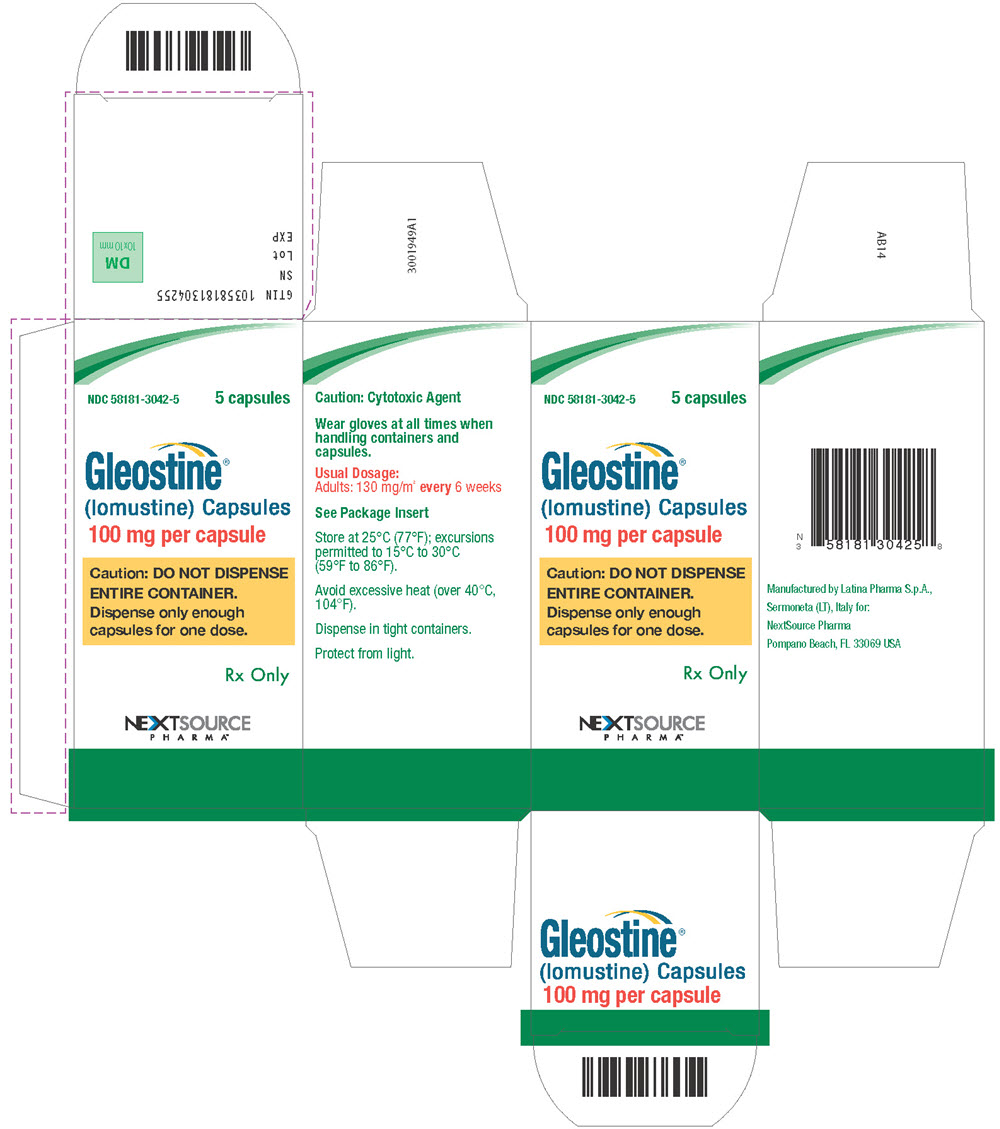Label: GLEOSTINE- lomustine capsule, gelatin coated
- NDC Code(s): 58181-3040-5, 58181-3041-5, 58181-3042-5
- Packager: NextSource Biotechnology, LLC
- Category: HUMAN PRESCRIPTION DRUG LABEL
- DEA Schedule: None
- Marketing Status: New Drug Application
Drug Label Information
Updated January 23, 2024
If you are a consumer or patient please visit this version.
- Download DRUG LABEL INFO: PDF XML
- Official Label (Printer Friendly)
-
HIGHLIGHTS OF PRESCRIBING INFORMATION
These highlights do not include all the information needed to use GLEOSTINE safely and effectively. See full prescribing information for GLEOSTINE.
GLEOSTINE ®(lomustine) capsules, for oral use
Initial U.S. Approval: 1976WARNING: DELAYED MYELOSUPPRESSION and RISK OF OVERDOSAGE
See full prescribing information for complete boxed warning.
Delayed Myelosuppression
Gleostine causes myelosuppression including fatal myelosuppression.
Myelosuppression is delayed, dose-related, and cumulative.
Thrombocytopenia is generally more severe than leukopenia. Monitor blood counts and do not give Gleostine more frequently than every 6 weeks. ( 2.2, 2.3, 5.1)
Risk of Overdosage
PRESCRIBE, DISPENSE, AND ADMINISTER ONLY ENOUGH
CAPSULES FOR ONE DOSE. Fatal toxicity occurs with overdosage of Gleostine. Both physician and pharmacist should emphasize to patient that only one dose of Gleostine is taken every 6 weeks. ( 2.1, 5.2, 10)
INDICATIONS AND USAGE
Gleostine is an alkylating drug indicated for the treatment of patients with:
DOSAGE AND ADMINISTRATION
- Recommended dose in adult and pediatric patients is 130 mg/m 2orally every 6 weeks. ( 2.1)
- Round dose to nearest 10 mg.
- Give as a single oral dose and do not repeat for at least 6 weeks.
DOSAGE FORMS AND STRENGTHS
Capsules: 10 mg, 40 mg, and 100 mg ( 3)
WARNINGS AND PRECAUTIONS
- Pulmonary toxicity: Pulmonary infiltrates and/or fibrosis occurs with Gleostine. Perform pulmonary function tests prior to treatment and repeat frequently. Permanently discontinue Gleostine in patients diagnosed with pulmonary fibrosis. ( 5.3)
- Secondary malignancies: Acute leukemia and myelodysplasia can occur with long-term use. ( 5.4)
- Hepatotoxicity: Increased levels of transaminases, alkaline phosphatase and bilirubin can occur with Gleostine. Monitor liver function. ( 5.5)
- Nephrotoxicity: Can cause renal failure. Monitor renal function. ( 5.6)
- Embryo-fetal toxicity: Can cause fetal harm. Advise males and females of reproductive potential of the potential risk to a fetus and to use effective contraception. ( 5.7, 8.1, 8.3)
ADVERSE REACTIONS
Common adverse reactions include delayed myelosupression, nausea, vomiting, stomatitis, and alopecia. ( 6)
To report SUSPECTED ADVERSE REACTIONS, contact NextSource Biotechnology at 855- 672-2468 or FDA at 1-800-FDA-1088 or www.fda.gov/medwatch.
See 17 for PATIENT COUNSELING INFORMATION.
Revised: 1/2024
-
Table of Contents
FULL PRESCRIBING INFORMATION: CONTENTS*
WARNING: DELAYED MYELOSUPPRESSION and RISK OF OVERDOSAGE
1 INDICATIONS AND USAGE
1.1 Brain Tumors
1.2 Hodgkin's Lymphoma
2 DOSAGE AND ADMINISTRATION
2.1 Important Prescribing and Dispensing Information
2.2 Recommended Dose
2.3 Dose Modifications
3 DOSAGE FORMS AND STRENGTHS
4 CONTRAINDICATIONS
5 WARNINGS AND PRECAUTIONS
5.1 Delayed Myelosuppression
5.2 Risk of Overdosage
5.3 Pulmonary Toxicity
5.4 Secondary Malignancies
5.5 Hepatotoxicity
5.6 Nephrotoxicity
5.7 Embryo-Fetal Toxicity
6 ADVERSE REACTIONS
8 USE IN SPECIFIC POPULATIONS
8.1 Pregnancy
8.2 Lactation
8.3 Females and Males of Reproductive Potential
8.4 Pediatric Use
8.5 Geriatric Use
10 OVERDOSAGE
11 DESCRIPTION
12 CLINICAL PHARMACOLOGY
12.1 Mechanism of Action
12.2 Pharmacodynamics
12.3 Pharmacokinetics
13 NONCLINICAL TOXICOLOGY
13.1 Carcinogenesis, Mutagenesis, Impairment of Fertility
15 REFERENCES
16 HOW SUPPLIED/STORAGE AND HANDLING
16.1 How Supplied
16.2 Storage and Handling
17 PATIENT COUNSELING INFORMATION
- *
- Sections or subsections omitted from the full prescribing information are not listed.
-
BOXED WARNING
(What is this?)
WARNING: DELAYED MYELOSUPPRESSION and RISK OF OVERDOSAGE
DELAYED MYELOSUPPRESSION
Gleostine causes myelosuppression including fatal myelosuppression. Myelosuppression is delayed, dose-related, and cumulative; occurring 4 to 6 weeks after drug administration and persisting for 1 to 2 weeks. Thrombocytopenia is generally more severe than leukopenia. Cumulative myelosuppression from Gleostine is manifested by greater severity and longer duration of cytopenias. Monitor blood counts for at least 6 weeks after each dose. Do not give Gleostine more frequently than every 6 weeks [see Warnings and Precautions ( 5.1), Dosage and Administration ( 2.2, 2.3)] .
RISK OF OVERDOSAGE
PRESCRIBE, DISPENSE, AND ADMINISTER ONLY ENOUGH CAPSULES FOR ONE DOSE. Fatal toxicity occurs with overdosage of Gleostine. Both physician and pharmacist should emphasize to the patient that only one dose of Gleostine is taken every 6 weeks [see Dosage and Administration ( 2.1), Warnings and Precautions ( 5.2), Overdosage ( 10)] .
- 1 INDICATIONS AND USAGE
-
2 DOSAGE AND ADMINISTRATION
2.1 Important Prescribing and Dispensing Information
PRESCRIBE ONLY ONE DOSE FOR EACH TREATMENT CYCLE. DO NOT DISPENSE ENTIRE CONTAINER.Dispense only a sufficient number of capsules for one dose.
Confirm the total dose prescribed by the physician and the appropriate combination of capsule strengths.
Dispense only the appropriate number of Gleostine capsules required for the administration of a single dose.
The prescribed dose may consist of two or more different strengths and colors of capsules.
Instruct patients that Gleostine is taken as a single oral dose and will not be repeated for at least 6 weeks. Taking more than the recommended dose causes toxicities, including fatal outcomes [see Warnings and Precautions ( 5.2) and Overdosage ( 10)] .
Gleostine is a cytotoxic drug. Follow applicable special handling and disposal procedures. 1
To minimize the risk of dermal exposure, always wear impervious gloves when handling bottles containing Gleostine capsules. Do not break Gleostine capsules; avoid exposure to broken capsules. If dermal contact occurs, wash areas of skin contact immediately and thoroughly.
2.2 Recommended Dose
The recommended dose of Gleostine in adult and pediatric patients is 130 mg/m 2taken as a single oral dose every 6 weeks. Round doses to the nearest 10 mg. Give as a single oral dose and do not repeat for at least 6 weeks. Reduce dose to 100 mg/m 2every 6 weeks in patients with compromised bone marrow function. Also reduce dose accordingly when using with other myelosuppressive drugs.
2.3 Dose Modifications
Perform weekly complete blood counts and withhold each subsequent dose for more than 6 weeks if needed until platelet counts recover to 100,000/mm 3or greater and leukocytes recover to 4000/mm 3or greater [see Warnings and Precautions ( 5.1)] .
Modify each dose of Gleostine according to the hematologic response of the preceding dose as described in Table 1:
Table 1. Dose Modifications for Gleostine Nadir After Prior Dose
Dose Adjustment
Leukocytes (/mm 3)
Platelets (/mm 3)
≥ 4000
≥ 100,000
None
3000 – 3999
75,000 – 99,999
None
2000 – 2999
25,000 – 74,999
Reduce dose by 30%
< 2000
< 25,000
Reduce dose by 50%
- 3 DOSAGE FORMS AND STRENGTHS
- 4 CONTRAINDICATIONS
-
5 WARNINGS AND PRECAUTIONS
5.1 Delayed Myelosuppression
Gleostine causes myelosuppression that can result in fatal infections and bleeding. Myelosuppression from Gleostine is delayed, dose-related, and cumulative. It usually occurs 4 to 6 weeks after drug administration and persists for 1 to 2 weeks. Thrombocytopenia is generally more severe than leukopenia. Cumulative myelosuppression from Gleostine is manifested by greater severity and longer duration of cytopenias.
Monitor blood counts for at least 6 weeks after each dose. Do not give Gleostine more frequently than every 6 weeks. Adjust dose based on nadir blood counts from prior dose [see Dosage and Administration ( 2.3)].
5.2 Risk of Overdosage
Fatal toxicity occurs with overdosage of Gleostine. Dispensing or administering more than one dose can lead to fatal toxicity.
Prescribe only one dose at a time. Dispense only enough capsules for one dose. Both physician and pharmacist should emphasize to the patient that only one dose of Gleostine is taken every 6 weeks [see Dosage and Administration ( 2.1) and Overdosage ( 10)].
5.3 Pulmonary Toxicity
Pulmonary toxicity characterized by pulmonary infiltrates and/or fibrosis occurs with Gleostine. Patients with a baseline below 70% of the predicted Forced Vital Capacity (FVC) or Carbon Monoxide Diffusing Capacity (DL CO) are at increased risk. The onset of pulmonary toxicity occurs after an interval of 6 months or longer from the start of therapy, with cumulative doses of Gleostine usually greater than 1100 mg/m 2.
Obtain baseline pulmonary function tests prior to initiating treatment and repeat frequently during treatment. Permanently discontinue Gleostine in patients diagnosed with pulmonary fibrosis.
5.4 Secondary Malignancies
Secondary malignancies, including acute leukemia and myelodysplasia, occur with long term use.
5.5 Hepatotoxicity
Hepatic toxicity, manifested by increased levels of transaminases, alkaline phosphatase, and bilirubin occurs with Gleostine.
Monitor liver function.
5.6 Nephrotoxicity
Progressive renal failure with a decrease in kidney size occurs with Gleostine.
Monitor renal function.
5.7 Embryo-Fetal Toxicity
Based on animal data and its mechanism of action, Gleostine can cause fetal harm when administered to a pregnant woman. Embryo-fetal toxicity and teratogenicity occurred in rats and rabbits receiving lomustine daily during organogenesis at doses approximately two to four times the total human dose of 130 mg/m 2over 6 weeks (0.18 to 0.27 times the single human dose of 130 mg/m 2) based on body surface area (BSA). Advise pregnant women of the potential risk to a fetus. Advise females of reproductive potential to use effective contraception during treatment with Gleostine and for 2 weeks after the final dose. Advise males with female partners of reproductive potential to use effective contraception during treatment with Gleostine and for 3.5 months after the final dose [see Use in Specific Populations ( 8.1, 8.3)] .
-
6 ADVERSE REACTIONS
The following serious adverse reactions are discussed in greater detail in other sections of the labeling:
- Delayed myelosuppression [see Warnings and Precautions ( 5.1)]
- Risks of overdosage [see Warnings and Precautions ( 5.2)]
- Pulmonary toxicity [see Warnings and Precautions ( 5.3)]
- Secondary malignancies [see Warnings and Precautions ( 5.4)]
- Hepatotoxicity [see Warnings and Precautions ( 5.5)]
- Nephrotoxicity [see Warnings and Precautions ( 5.6)]
The following adverse reactions associated with the use of Gleostine were identified in clinical trials or postmarketing reports. Because these reactions were reported from a population of uncertain size, it is not possible to estimate their frequency, reliability, or establish a causal relationship to drug exposure.
Gastrointestinal disorders:nausea, vomiting, and stomatitis
Ocular disorders:optic atrophy, visual disturbances, and blindness
Neurologic disorders:disorientation, lethargy, ataxia, and dysarthria
Other:alopecia
-
8 USE IN SPECIFIC POPULATIONS
8.1 Pregnancy
Risk Summary
Based on animal data and its mechanism of action, Gleostine can cause fetal harm when administered to a pregnant woman [see Clinical Pharmacology ( 12.1)] . There are no available data on Gleostine exposure in pregnant women. Lomustine was teratogenic in rats and embryotoxic in rabbits at total dose levels approximately two to four times the total human dose of 130 mg/m 2over 6 weeks (0.18 to 0.27 times the single human dose of 130 mg/m 2) based on BSA [see Data]. Advise pregnant women of the potential risk to a fetus.
In the U.S. general population, the estimated background risk of major birth defects and miscarriage in clinically recognized pregnancies is 2-4% and 15-20%, respectively.
Animal Data
Lomustine was administered by intraperitoneal injection daily to pregnant rats during the period of organogenesis at dose levels of 0, 2, 4, 6, and 8 mg/kg. Resorption rates and post-implantation loss occurred at doses greater than or equal to 4 mg/kg (approximately 0.18 times the clinical dose of 130 mg/m 2based on BSA or approximately twice the total clinical dose of lomustine over 6 weeks). Malformations (omphalocele, ectopia cordis, scoliosis, syndactyly, hydrocephalus, microphthalmia, anophthalmia, anomalies of aortic arch, dextrocardia, malpositioning of the ovaries and testes, sternoschisis, and shortened/misshapen bone of the fore or hind limbs) and decreased fetal body weight occurred at all dose levels. In pregnant rabbits treated with lomustine at 3 mg/kg (approximately 0.27 times the 130 mg/m 2clinical dose based on BSA or approximately four times the total clinical dose of lomustine over 6 weeks) during organogenesis, there were increases in abortions and decreases in surviving pup weight that persisted postnatally.
8.2 Lactation
Risk Summary
There is no information on the presence of lomustine or its metabolites in human milk, its effects on the breastfed infant, or its effects on milk production. Because of the potential for serious adverse reactions in breastfed infants from Gleostine, advise women not to breastfeed during treatment with Gleostine and for 2 weeks after the final dose.
8.3 Females and Males of Reproductive Potential
Contraception
Females
Based on animal data and its mechanism of action, Gleostine can cause fetal harm [see Use in Specific Populations ( 8.1)] . Advise females of reproductive potential to use effective contraception during treatment and for 2 weeks after the final dose.
Males
Based on Gleostine's mechanism of action, advise males with female partners of reproductive potential to use effective contraception during treatment with Gleostine and for 3.5 months after the final dose [see Clinical Pharmacology ( 12.1)] .
Infertility
Based on animal findings and its mechanism of action, Gleostine may result in reduced fertility in males and females of reproductive potential [see Nonclinical Toxicology ( 13.1)] .
8.4 Pediatric Use
Pediatric use, including dose, is not based on adequate and well-controlled clinical studies.
8.5 Geriatric Use
No data in the clinical studies of Gleostine are available for patients 65 years of age and over to determine whether they respond differently than younger patients. Other reported clinical experience has not identified differences in responses between elderly and younger patients. In general, dose selection for an elderly patient should be cautious, reflecting the greater frequency of decreased hepatic, renal, or cardiac function and of concomitant disease or other drug therapy.
Lomustine and its metabolites are known to be substantially excreted by the kidney, and the risk of toxic reactions to this drug may be greater in patients with impaired renal function. Because elderly patients are more likely to have decreased renal function, care should be taken in dose selection, and renal function should be monitored.
-
10 OVERDOSAGE
Overdosage with Gleostine has occurred, including fatal cases [see Dosage and Administration ( 2.1), Warnings and Precautions ( 5.2)]. Overdosage causes severe myelosuppression, as well as abdominal pain, diarrhea, vomiting, anorexia, lethargy, dizziness, abnormal hepatic function, cough, and shortness of breath.
No antidotes exist for Gleostine overdosage.
-
11 DESCRIPTION
Gleostine (lomustine) is an alkylating drug for oral administration. The chemical name for lomustine is 1-(2-chloro-ethyl)-3-cyclohexyl-1-nitrosourea and the molecular formula is C 9H 16ClN 3O 2. The molecular weight is 233.71. Lomustine is a yellow powder, which is soluble in 10% ethanol (0.05 mg per mL) and in absolute alcohol (70 mg per mL). Lomustine is insoluble in water (<0.05 mg per mL).
The chemical structure is:
Gleostine is supplied as 10 mg, 40 mg, and 100 mg capsules and contains the following inactive ingredients: magnesium stearate NF and mannitol USP. The capsule shells are composed of gelatin and coloring pigments, depending on the strength: titanium dioxide, and/or yellow iron oxide, and/or Indigotine – FD&C Blue2.
-
12 CLINICAL PHARMACOLOGY
12.1 Mechanism of Action
Lomustine alkylates DNA and RNA. As with other nitrosoureas, it may also inhibit several key enzymatic processes by carbamoylation of amino acids in proteins.
-
13 NONCLINICAL TOXICOLOGY
13.1 Carcinogenesis, Mutagenesis, Impairment of Fertility
Lomustine is carcinogenic in rats and mice, producing a marked increase in tumor incidence in doses lower than those employed clinically.
In female rats, daily intraperitoneal treatment with lomustine for 2 weeks prior to mating with untreated males resulted in dose dependent decreases in number of corpora lutea and resorption rates with no live births at a dose of 3 mg/kg (approximately 0.14 times the recommended clinical dose of 130 mg/m 2based on body surface area (BSA), or approximately twice the total clinical dose of lomustine over 6 weeks) and decreased pup survival during the first 4 postnatal days at doses greater than or equal to 1.5 mg/kg (a daily dose of approximately 0.06 times the recommended clinical dose of 130 mg/m 2based on BSA or approximately equal to the total clinical dose of lomustine over 6 weeks). Gleostine may also result in decreased male fertility. Intraperitoneal injection of lomustine resulted in decreased fertility in male rats mated to untreated females based on decreased implantations and decreased fetal body weight at weekly doses greater than or equal to 5 mg/kg (approximately 0.23 times the single clinical dose of 130 mg/m 2based on BSA, or approximately equal to the total clinical dose of lomustine over 6 weeks), and increased resorptions at doses greater than or equal to 2.5 mg/kg/week.
- 15 REFERENCES
-
16 HOW SUPPLIED/STORAGE AND HANDLING
16.1 How Supplied
Gleostine is available in three strengths, distinguishable by the color of the capsules, in individual bottles of 5 capsules each:
Strength
Capsule Description
NDC Code
100 mg
Moss green cap and body, imprinted in black ink, with "CPL" over "3032" on the cap and "100 mg" on the body of the capsule.
58181-3042-5
40 mg
White cap and a moss green body, imprinted in black ink, with "CPL" over "3031" on the cap and "40 mg" on the body of the capsule.
58181-3041-5
10 mg
White cap and body, imprinted in black ink, with "CPL" over "3030" on the cap and "10 mg" on the body of the capsule
58181-3040-5
16.2 Storage and Handling
Store at 25°C (77°F); excursions permitted to 15°C to 30°C (59°F to 86°F) [see USP Controlled Room Temperature]. Avoid temperatures over 40°C (104°F).
Gleostine is a cytotoxic drug. Follow applicable special handling and disposal procedures. 1
To minimize the risk of dermal exposure, always wear impervious gloves when handling bottles containing Gleostine capsules. Do not break Gleostine capsules; avoid exposure to broken capsules. If dermal contact occurs, wash areas of skin contact immediately and thoroughly.
-
17 PATIENT COUNSELING INFORMATION
Myelosuppression
Advise patients that periodic assessment of their blood counts are required. Advise patients to contact their healthcare provider for new onset of bleeding or fever or symptoms of infection [see Warnings and Precautions ( 5.1)].
Overdosage
Advise patients that toxicity including fatal toxicity occurs with Gleostine overdosage [see Warnings and Precautions ( 5.2), Overdosage ( 10), Dosage and Administration ( 2.1)].
Advise patients to take Gleostine as directed:
- Gleostine is taken as a single oral dose that will not be repeated for at least 6 weeks.
- Use of the recommended dose at less than 6 week intervals leads to toxicities including fatal toxicities.
- Each dose may consist of 2 or more different strengths and colors of capsules.
Pulmonary Fibrosis
Advise patients to contact their healthcare provider for new or worsening cough, chest pain, or shortness of breath [see Warnings and Precautions ( 5.3)] .
Hepatotoxicity
Inform patients that Gleostine can cause hepatotoxicity and that liver function monitoring during treatment is necessary [see Warnings and Precautions ( 5.5)].
Nephrotoxicity
Inform patients that Gleostine can cause nephrotoxicity and that renal function and electrolyte monitoring during treatment is necessary [see Warnings and Precautions ( 5.6)].
Embryo-Fetal Toxicity
Advise females of reproductive potential of the potential risk to a fetus and to inform their healthcare provider of a known or suspected pregnancy [see Warnings and Precautions ( 5.7), Use in Specific Populations ( 8.1)] .
Advise females of reproductive potential to use effective contraception during treatment with Gleostine and for at least 2 weeks after the final dose [see Use in Specific Populations ( 8.3)].
Advise male patients with female partners of reproductive potential to use condoms during treatment with Gleostine and for 3.5 months after the final dose [see Use in Specific Populations ( 8.3)] .
Lactation
Advise women not to breastfeed during treatment with Gleostine and for 2 weeks after the final dose [see Use in Specific Populations ( 8.2)].
Infertility
Advise females and males of reproductive potential of the potential for reduced fertility from Gleostine [see Use in Specific Populations ( 8.3) and Nonclinical Toxicology ( 13.1)].

Manufactured by Latina Pharma S.p.A., Sermoneta (LT), Italy for:
NextSource Pharma
Pompano Beach, FL 33069 USA - PRINCIPAL DISPLAY PANEL
- PRINCIPAL DISPLAY PANEL
- PRINCIPAL DISPLAY PANEL
-
INGREDIENTS AND APPEARANCE
GLEOSTINE
lomustine capsule, gelatin coatedProduct Information Product Type HUMAN PRESCRIPTION DRUG Item Code (Source) NDC:58181-3041 Route of Administration ORAL Active Ingredient/Active Moiety Ingredient Name Basis of Strength Strength LOMUSTINE (UNII: 7BRF0Z81KG) (LOMUSTINE - UNII:7BRF0Z81KG) LOMUSTINE 40 mg Inactive Ingredients Ingredient Name Strength MAGNESIUM STEARATE (UNII: 70097M6I30) MANNITOL (UNII: 3OWL53L36A) Product Characteristics Color green (green) , white (white) Score no score Shape CAPSULE (CAPSULE) Size 18mm Flavor Imprint Code CPL;3031;40;mg Contains Packaging # Item Code Package Description Marketing Start Date Marketing End Date 1 NDC:58181-3041-5 1 in 1 CARTON 08/18/2014 1 5 in 1 BOTTLE; Type 0: Not a Combination Product Marketing Information Marketing Category Application Number or Monograph Citation Marketing Start Date Marketing End Date NDA NDA017588 08/18/2014 GLEOSTINE
lomustine capsule, gelatin coatedProduct Information Product Type HUMAN PRESCRIPTION DRUG Item Code (Source) NDC:58181-3040 Route of Administration ORAL Active Ingredient/Active Moiety Ingredient Name Basis of Strength Strength LOMUSTINE (UNII: 7BRF0Z81KG) (LOMUSTINE - UNII:7BRF0Z81KG) LOMUSTINE 10 mg Inactive Ingredients Ingredient Name Strength MAGNESIUM STEARATE (UNII: 70097M6I30) MANNITOL (UNII: 3OWL53L36A) Product Characteristics Color white (white) Score no score Shape CAPSULE (CAPSULE) Size 16mm Flavor Imprint Code CPL;3030;10;mg Contains Packaging # Item Code Package Description Marketing Start Date Marketing End Date 1 NDC:58181-3040-5 1 in 1 CARTON 08/18/2014 1 5 in 1 BOTTLE; Type 0: Not a Combination Product Marketing Information Marketing Category Application Number or Monograph Citation Marketing Start Date Marketing End Date NDA NDA017588 08/18/2014 GLEOSTINE
lomustine capsule, gelatin coatedProduct Information Product Type HUMAN PRESCRIPTION DRUG Item Code (Source) NDC:58181-3042 Route of Administration ORAL Active Ingredient/Active Moiety Ingredient Name Basis of Strength Strength LOMUSTINE (UNII: 7BRF0Z81KG) (LOMUSTINE - UNII:7BRF0Z81KG) LOMUSTINE 100 mg Inactive Ingredients Ingredient Name Strength MAGNESIUM STEARATE (UNII: 70097M6I30) MANNITOL (UNII: 3OWL53L36A) Product Characteristics Color green (green) Score no score Shape CAPSULE (CAPSULE) Size 19mm Flavor Imprint Code CPL;3032;100;mg Contains Packaging # Item Code Package Description Marketing Start Date Marketing End Date 1 NDC:58181-3042-5 1 in 1 CARTON 08/18/2014 1 5 in 1 BOTTLE; Type 0: Not a Combination Product Marketing Information Marketing Category Application Number or Monograph Citation Marketing Start Date Marketing End Date NDA NDA017588 08/18/2014 Labeler - NextSource Biotechnology, LLC (078779322)

